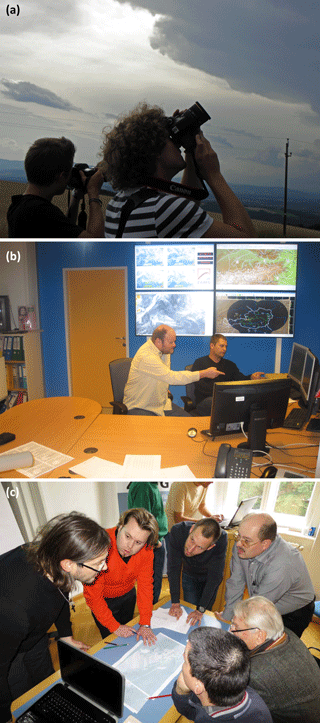The trilateral collaboration between ZAMG, Skywarn Austria and ESSL is
beneficial for everyone involved. It is the most advanced of such
collaborations in Europe and was awarded “Best Practice” by the European
Meteorological Society in 2016. A survey among European National
Meteorological Services, which was conducted concomitantly to our study,
showed that an increasing number of them are utilizing spotter reports, but
none of them links training and quality control in our way yet (Krennert et
al., 2018). However, we do not only want to advocate a mere copy of this
formula for success to other countries, but we also wish to give a prospect
of a broader, pan-European level of employing the general public into the
severe weather warning process.
In early 2017, ESSL released its European Weather OBserver application for
mobile phones (EWOB, https://www.essl.org/ewob/, last access: 5 May 2018), which offers
a new, simple way to submit a variety of weather observations and
information about their impact. It is not limited to severe weather events
any more. It therefore does not require the observers to be trained or
conscious of challenging reporting criteria. The generalization from
“severe weather observations” to any kind of “weather observations”
reduces the efforts of reporting to a minimum and can attract a larger
number of people.
Despite the success of TSN Austria, it shall be clear that significant
resources are necessary to ensure the training process of voluntary
observers, and that only a limited number of people is interested enough to
care about specific reporting criteria, undergo this training and become a
Trusted Spotter. In contrast, still a large number of people exist whose
enthusiasm is not big enough to shoulder these efforts, but who are yet
ready to informally report on observed weather conditions when stimulated.
This is also evident from the multitude of reactions to weather-related
information on social media sites of e.g. newspapers, TV or radio stations,
or mere chat-rooms. EWOB aims at these people by alluring them with an easy
interface for reporting and an appealing graphic display of their immediate
reporting “success”.
In contrast to a naturally limited number of high-quality reports on severe
weather events that can be gained from a network of Trusted Spotters, the
potential value of EWOB data inheres in their quantity instead of their
quality. Realistically the majority of reports to the EWOB database will be
given by untrained observers, thus, the report is given without quality
control. However, their sheer number awards them collective information.
Users can focus on those reports relevant for their individual purposes. For
example, reports of fog, freezing drizzle, phase changes between snow and
rain, small hail, or strong wind gusts are not high-impact events yet, but
may be first indications of higher-impact situations to evolve. In
particular, those EWOB reports meeting ESWD criteria may be sorted out and
in a next step saved in the ESWD database after a customary quality control.
Due to the simplicity of the procedure and the permission to report any kind
of weather, EWOB constitutes a more general approach to engage citizens into
weather forecasting and warning. Ideally, a system of Trusted Spotters shall
be included into such a broader approach. Both concepts – the emphasis on
quality of a Trusted Spotter system and the emphasis on quantity of the EWOB
approach – are complementary for an employment of the general public into
an effective feedback loop, which can improve the nowcasting and warning of
high-impact weather situations.






